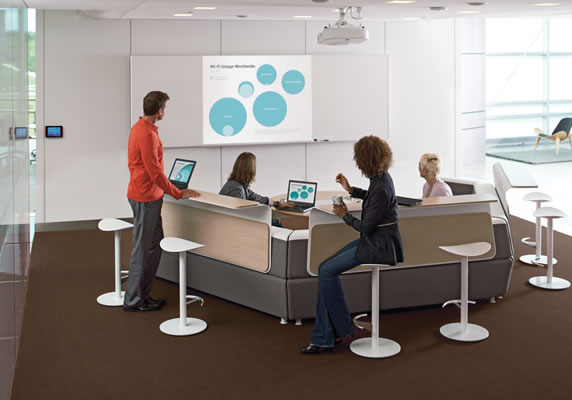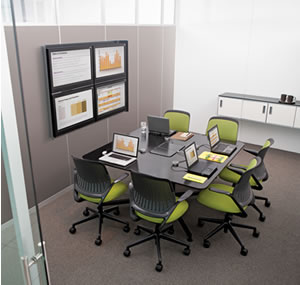Workers today are at the epicenter of a major shift in work styles as they toggle between their physical and increasingly virtual presence. One sign of this shift: the growth of individual and group videoconferencing. Every day, everywhere, people are meeting and interacting on video.
Distributed teams are meeting on video for weekly sessions, while individual team members meet daily on video for a quick touch-base. As a result, the way we connect to live, work, and learn is giving way to an emerging new behavior: living on video. Research shows that this behavior is following a natural course of market adoption: for some individuals and industries, it’s a bold new way to meet from afar. For others, it’s the new normal.
What’s driving this trend? Globalization and enabled by lower bandwidth requirements, higher-quality resolution, and a broader range of scalable technologies and price points. Video used to mean big equipment and high cost, often with entire rooms or spaces within a high-rise building dedicated to its exclusive use.
Now, however, video is mobile. It functions with one push of a button, and is inexpensive (or free). And because video comes to us on small devices that fit in our pocket or purse, its utility and frequent use increases, too. Video is everywhere, becoming a ubiquitous medium that’s economically accessible and increasingly available for us to choose.
We’re living on video at work because it helps us be more effective. There’s an immediate connection and a wealth of content that video provides versus other media. No longer are videoconferences being held just in dedicated spaces.
Tenants can hold their phones, aim them toward an event or a business presentation, record it, and send it anywhere in the world. They can get feedback on a prototype they created. They can interview a customer on the spot and share it. The uses are endless, and the impact is huge. Video helps leverage an increasingly mobile workforce. There are countless people in leadership positions around the world managing distributed teams that not only need to communicate using video as a medium, but also need far more insightfully designed environments to host those conversations.
 Creating a Destination
Creating a Destination
As videoconferencing grows at a rapid rate, our researchers see it becoming a primary medium for most forms of collaboration, communication, and connection. As people shift to using video more as a part of their everyday lives, that behavioral change will lead to a dramatically different work environment from what we see today.
Even though video use has accelerated, the solutions designed to improve the user experience have not kept pace. As a result, there is an opportunity to transform today’s complicated, static, and technology-centered videoconferencing solutions into complete applications that are more intuitive, dynamic, and user-centered.
“Living on video” requires the physical workplace to offer a “palette of presence”: a range of spaces that support people switching back and forth between a physical and virtual presence. With so many businesses are spread out geographically, living on video can help compensate for the distance.
Simply providing video tools isn’t enough. We need to think about the intersection of social, spatial, and informational needs of people. Socially, for example, we look at the dynamics of how people are interacting on video when connecting one-on-one with another person or with a group. To make sure your high-rise facility is prepared, ask yourself these questions:
- What if a tenant or occupant needs to break out of a larger videoconference and have a brief side conversation? Is there a nearby space for them to see and interact not only with people, but also the information needed?
- Does the building need to offer a system with better scaled screen and camera positions that work for one or two people comfortably?
- Does the space within the building help decrease distractions and increase engagement through lighting and acoustics?
- In videoconferencing spaces, are cameras placed for optimally inclusive sightlines and to assure that remote participants can see teammates and the whiteboard?
Today, it’s just employees and their devices – wherever they may be. We need to design workspace destinations that augment technology so it dramatically improves the experience for tenants and occupants. Designing for these experiences will look more like an ecology of work behaviors that live in a close relationship to situating physical and virtual circumstances.
Solving for these needs will demand a well-rounded response to a set of increasingly available choices – allowing people to self-select where they want to work, how they want to work, or who they want to work with. That’s because the places and spaces that offer users choice and control are the ones that will be chosen.
 Six Things to Consider When Designing for Distributed Teams
Six Things to Consider When Designing for Distributed Teams
- Think about camera and microphone placements carefully. Develop a layout that allows all users to be on camera and clearly audible. Include multiple screens so participants can see each other and their content at the same time, making sure people can move and stay on-camera without disrupting the flow of interaction.
- Create work zones that allow people to move fluidly between group work and privacy. People in collaborative teams make quick switches between these modes throughout the day. Glass walls within the room can create acoustical separation while supporting continued visual access. Enclaves immediately adjacent to the team space allow team members to get away without going away.
- Design the environment to encourage movement and a range of postures so that participants can stay energized and engaged. Stool-height tables encourage standing up and staying on camera, or make it easy to transition off and back into the conference. A lounge setting with videoconferencing is another effective way to encourage movement and informality.
- Think about both sides of the experience. Provide similar environments in all locations, equipped with the same level of tools and technology controls. Incorporate abundant display surfaces, both analog and digital, to help distributed teams develop a shared mind.
- Consider how the space can help build trust. For instance, just outside the team room, a “wormhole”—a continuously open, real-time video connection that acts like an open window between two locations—can help promote social exchanges as people come and go.
- Plan for a range of team sizes and videoconferencing exchanges. One-on-one interactions, paired with work and collaboration subsets, are as important as full team sessions. Distribute as many choices as possible – videoconferencing kiosks adjacent to the team space, nooks within it, and even mobile solutions – to leverage real estate and encourage use of the technology.
Images courtesy of Steelcase


